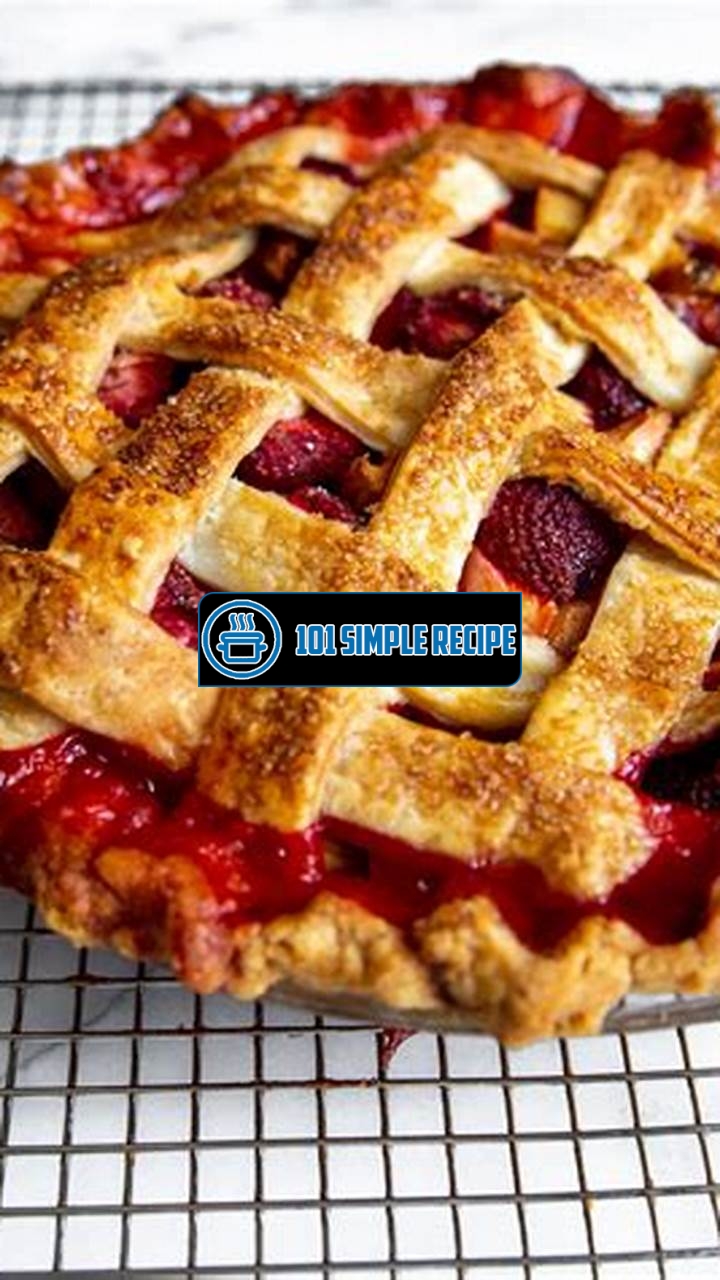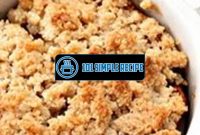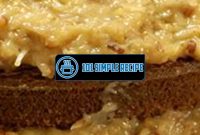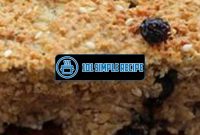Are you tired of searching for the perfect gluten-free pie crust recipe? Look no further! In this article, you will learn how to master the art of creating a delicious gluten-free pie crust that will impress even the toughest critics. Whether you have a gluten intolerance or are simply looking for a healthier alternative, this recipe will have you enjoying pie just like before. With a few simple ingredients and some helpful tips, you’ll be well on your way to creating a golden, flaky pie crust that will leave everyone asking for more. So, let’s get started and dive into the wonderful world of gluten-free baking!

The Basics of Gluten Free Pie Crust
Gluten free pie crust has gained a lot of attention in recent years, especially among those with dietary restrictions. It offers a delicious alternative to traditional pie crusts, and many people have embraced it as a healthier option. In this section, we will explore what gluten free pie crust is and why it has become so popular.
What is Gluten Free Pie Crust?
Gluten free pie crust is a type of crust that is made without the protein gluten. Gluten is commonly found in wheat, barley, and rye, and it gives traditional pie crust its elasticity and structure. However, for individuals with celiac disease or gluten sensitivities, consuming gluten can cause digestive issues and other health problems. As a result, gluten free pie crust offers a safe and delicious alternative.
Gluten free pie crusts are typically made using a combination of gluten free flours, such as rice flour, almond flour, or oat flour. These flours are often combined with other ingredients such as butter or shortening, sugar, and salt to create a dough that can be rolled out and used as a crust for various types of pies.
One important thing to note is that gluten free pie crusts can sometimes be more delicate and crumbly compared to traditional crusts. However, with the right technique and ingredients, it is possible to achieve a flaky and flavorful gluten free crust that rivals its gluten-containing counterparts.
The Rise in Popularity of Gluten Free Pie Crust
The popularity of gluten free pie crust has soared in recent years, and there are several reasons behind this trend. First and foremost, the increasing awareness and diagnosis of celiac disease and gluten sensitivities have led to a higher demand for gluten free alternatives in various food categories, including pie crusts.
Moreover, many people have adopted a gluten free lifestyle as a personal choice, even if they do not have celiac disease or gluten sensitivities. They believe that eliminating gluten from their diets can help improve their overall well-being, reduce inflammation, and boost energy levels. As a result, the demand for gluten free products, including pie crusts, has skyrocketed.
Additionally, with advancements in gluten free baking techniques and the availability of high-quality gluten free ingredients, it has become easier than ever to create delicious and satisfying gluten free pie crusts. This accessibility has further contributed to the rise in popularity of gluten free baking.
Benefits of Using Gluten Free Pie Crust
There are numerous benefits to using gluten free pie crust in your baking endeavors. Firstly, as mentioned earlier, it allows individuals with celiac disease or gluten sensitivities to enjoy pies without experiencing adverse health effects. It provides them with an opportunity to indulge in a classic dessert without compromising their dietary restrictions.
Furthermore, gluten free pie crusts often incorporate alternative flours that offer various nutritional benefits. For example, almond flour is high in protein and healthy fats, while oat flour is rich in fiber and can help regulate blood sugar levels. By using these gluten free flour substitutes, you can add a nutritional boost to your pies.
Lastly, using gluten free pie crusts opens up a realm of creativity and flavors. You can experiment with different flour blends and add unique ingredients like spices, herbs, or nuts to enhance the taste profile of your crust. These creative combinations can elevate your pies and make them stand out from the crowd.
In conclusion, gluten free pie crust has become a popular choice for those with dietary restrictions due to its ability to cater to individuals with celiac disease or gluten sensitivities. Its rise in popularity is also fueled by the increasing awareness of gluten-related health issues and the availability of high-quality gluten free ingredients. The benefits of using gluten free pie crust include providing a safe option for those with dietary restrictions, incorporating alternative flours with added nutritional benefits, and allowing for creative flavor profiles. So why not master the art of creating a gluten free pie crust and enjoy delicious pies while accommodating various dietary needs?
Choosing the Right Ingredients
Creating a successful gluten free pie crust starts with selecting the right ingredients. The key to a delicious and flaky crust lies in choosing the right flour, fat, and binder substitutes. By understanding the options available, you can ensure that your gluten free pie crust is just as tasty as its traditional counterpart.
Flour Alternatives for Gluten Free Pie Crust
When it comes to gluten free baking, the most important ingredient to consider is the flour. Fortunately, there are many alternatives to wheat flour that can be used to create a delicious pie crust. Some popular options include:
- Almond Flour: Made from finely ground almonds, almond flour adds a nutty flavor and a tender texture to your crust. It’s a great choice for pies with fruit or custard fillings.
- Coconut Flour: Derived from dried coconut meat, coconut flour is rich in fiber and adds a slight sweetness to your crust. It pairs well with tropical or chocolatey pie fillings.
- Rice Flour: Made from finely milled rice, this flour is a versatile choice for gluten free baking. It has a neutral flavor and produces a crust that is light and crispy.
- Potato Starch: Derived from potatoes, potato starch adds moisture and a delicate texture to your crust. It’s a great option for savory pies such as quiches or pot pies.
- Oat Flour: Ground from oats, oat flour lends a subtle nuttiness to your crust. It pairs well with pies featuring berries or apples.
Important note: Experimenting with different flour alternatives can help you find the perfect texture and flavor for your gluten free pie crust. Feel free to mix and match to create a unique combination that suits your tastes!
Fat Options for Gluten Free Pie Crust
In addition to the flour, the choice of fat in your gluten free pie crust can greatly affect its taste and texture. Here are some popular fat options to consider:
- Butter: Butter adds a rich and flaky texture to your crust. It’s best to use unsalted butter for better control of the pie’s overall saltiness.
- Shortening: Made from vegetable oil, shortening gives your crust a tender and delicate crumb. It’s ideal for creating a light and airy pie crust.
- Coconut Oil: This plant-based fat provides a subtle coconut flavor to your crust. It works best when mixed with another fat, such as butter or shortening, for a balanced texture.
- Vegetable Oil: Perfect for those who prefer a healthier option, vegetable oil creates a moist and tender crust. It’s an excellent choice for vegan or dairy-free recipes.
Important note: Experiment with different fat options to find the flavor and texture that suits your preferences. Combining different fats can also yield unique results, so don’t be afraid to get creative!
Binder Substitutes in Gluten Free Pie Crust
One of the challenges in gluten free baking is finding a suitable binder that holds the crust together. Gluten, a protein found in wheat flour, provides the structure in traditional pie crusts. However, there are several effective binder substitutes available for gluten free crusts:
- Xanthan Gum: Derived from fermented corn sugar, xanthan gum acts as a thickener and binder. It helps create a cohesive and elastic dough.
- Psyllium Husk Powder: Made from the outer husks of the psyllium plant’s seeds, this natural ingredient absorbs moisture and forms a gel-like consistency. It’s perfect for adding elasticity to your pie crust.
- Ground Flaxseeds: When mixed with water, ground flaxseeds produce a gel-like substance that helps bind the ingredients together. They also add a pleasant nutty flavor to your crust.
- Chia Seeds: Similar to flaxseeds, chia seeds can be used as a binder when combined with water. They also provide a little crunch to your crust.
Important note: Different binders may require different ratios and handling techniques. Ensure you follow the instructions provided for each substitute to achieve the best results.
In conclusion, by carefully selecting the right ingredients for your gluten free pie crust, you can create a delicious and flaky pastry that rivals its gluten-filled counterparts. Experimenting with different flour alternatives, fat options, and binder substitutes allows you to customize the texture and flavor to suit your taste preferences. Enjoy the process of mastering the art of creating a gluten free pie crust and impress your friends and family with your baking skills!
Tips for Preparing Gluten Free Pie Crust
Creating a gluten-free pie crust can be a challenging task, but with the right tips and techniques, you can achieve a perfect crust every time. Here are some helpful pointers to ensure your gluten-free pie crust turns out delicious and flaky.
Preparation Steps for Gluten Free Pie Crust
When it comes to preparing a gluten-free pie crust, proper ingredient selection and preparation methods are essential. Here are the steps to follow:
- Choose the right flour: Opt for a gluten-free flour mix that is specifically formulated for baking. This will help ensure the right texture and flavor in your pie crust.
- Chill the ingredients: Cooling the flour, butter, and water before working with them can help maintain the flakiness of the crust. Place the ingredients in the refrigerator for at least 30 minutes before use.
- Measure accurately: Gluten-free baking often requires precise measurements. Use a kitchen scale to weigh the ingredients for accuracy.
- Add binders: Since gluten-free flour lacks the elasticity of regular flour, it’s essential to add binders such as xanthan gum or psyllium husk powder. These additives help hold the crust together and prevent it from becoming crumbly.
Rolling and Handling Gluten Free Pie Crust
Rolling and handling the dough can be tricky when working with gluten-free pie crust. Here are some tips to make the process easier:
- Use parchment paper: Place a sheet of parchment paper on your work surface before rolling out the dough. This will prevent it from sticking and make it easier to transfer to the pie dish.
- Handle with care: Gluten-free dough is more delicate than regular dough, so handle it gently to avoid tearing. If the dough cracks, simply press it back together with your fingers.
- Roll between plastic wrap: To prevent the dough from sticking to the rolling pin, sandwich it between two sheets of plastic wrap. This will make it easier to roll out and transfer to the pie dish.
- Trim excess dough: After transferring the dough to the pie dish, trim any excess with a sharp knife. This will give your crust a neat and professional appearance.
Baking Techniques for Gluten Free Pie Crust
Proper baking techniques are crucial for achieving a golden and flaky gluten-free pie crust. Here’s what you need to know:
- Preheat the oven: Make sure your oven is preheated to the correct temperature before baking the pie crust. This will ensure even baking and prevent the crust from becoming soggy.
- Use pie weights: If you’re blind-baking the crust (baking it without filling), use pie weights or dried beans to prevent it from puffing up during baking. This will help maintain its shape.
- Brush with egg wash: For a glossy and golden crust, brush the top of the dough with an egg wash before baking. This will give your pie a professional and appetizing finish.
Note: It’s important to keep in mind that gluten-free pie crusts may require slightly longer baking times than regular crusts. Keep an eye on the pie as it bakes and adjust the baking time accordingly to ensure it’s fully cooked.
With these tips in mind, you can master the art of creating a gluten-free pie crust. Remember to choose the right ingredients, handle the dough gently, and follow proper baking techniques for the best results. Happy baking!
Enhancing Flavor and Texture
When it comes to creating a gluten free pie crust, one of the key challenges is achieving the same level of flavor and texture as traditional crusts. However, with a little creativity and experimentation, you can enhance both the taste and texture of your gluten free pie crust. Below, we will explore some innovative ways to elevate the flavor and texture of your crust, ensuring that you never compromise on taste.
Adding Herbs and Spices to Gluten Free Pie Crust
Herbs and spices are a fantastic way to add depth and complexity to your gluten free pie crust. Instead of sticking to the traditional plain crust, incorporate herbs and spices into the dough to infuse it with additional flavors. For example, you can try adding a teaspoon of dried thyme or rosemary to your crust mixture for a savory twist. Alternatively, cinnamon or nutmeg can add warmth and richness to your crust, perfect for sweet pies. The key is to experiment and find the right combination that complements the filling of your pie.
- Experiment with herbs like thyme or rosemary for a savory gluten free pie crust.
- Add cinnamon or nutmeg for a warm and aromatic gluten free crust for sweet pies.
Incorporating Nuts or Seeds in Gluten Free Pie Crust
Nuts and seeds not only provide an added crunch but also contribute to the overall flavor profile of your gluten free pie crust. Consider incorporating finely chopped almonds, pecans, or even chia seeds into your crust mixture. These ingredients not only enhance the texture but also impart a nutty and delicious taste. Additionally, they can add an extra layer of richness to your crust, making it more satisfying and indulgent.
- Experiment with finely chopped almonds, pecans, or chia seeds to give your gluten free crust a delightful crunch.
- Add a nutty twist to your crust by incorporating various nuts or seeds.
Experimenting with Sweeteners for Gluten Free Pie Crust
When it comes to sweetness, traditional pie crusts often rely on granulated or powdered sugar. However, in a gluten free pie crust, you may need to explore alternative sweeteners. Maple syrup, honey, or even coconut sugar can be used instead of traditional white sugar. These natural sweeteners not only enhance the taste but also bring a unique flavor to your crust. Experiment with different quantities and types of sweeteners to achieve the perfect balance of sweetness in your gluten free pie.
- Substitute traditional white sugar with natural sweeteners like maple syrup, honey, or coconut sugar for a healthier twist.
- Experience the subtle flavors of alternative sweeteners in your gluten free pie crust.
In conclusion, don’t shy away from experimenting with different flavors and textures when creating your gluten free pie crust. Explore the use of herbs, spices, nuts, seeds, and alternative sweeteners to elevate the taste and quality of your crust. Remember, the key is to experiment, have fun, and find the perfect combination that will make your pie crust truly outstanding.
Decorating and Presenting Gluten Free Pies
Impress your guests with beautifully decorated and presented gluten free pies. The visual appeal of a well-decorated pie can elevate your dessert to a whole new level. Here are some inspiring ideas to help you master the art of decorating and presenting your gluten free pies.
Creative Crust Designs for Gluten Free Pies
Add a touch of creativity to your gluten free pies by experimenting with unique crust designs. Not only will it make your pies visually appealing, but it will also showcase your artistic side. Here are some ideas to get you started:
- Create a braided crust: Weave strips of gluten free pie dough together to create a beautiful braided pattern. It adds an elegant touch to your pie and shows off your attention to detail.
- Use cookie cutters: Cut out different shapes from your gluten free pie dough using cookie cutters. Arrange these shapes on top of your pie to create a playful and eye-catching design.
- Create a lattice pattern: Weave strips of gluten free pie dough in a lattice pattern on top of your pie. This classic design adds a rustic charm to your dessert.
Note: Feel free to let your imagination run wild and come up with your own unique crust designs. The sky’s the limit!
Garnishing and Topping Ideas for Gluten Free Pies
Take your gluten free pies to the next level by adding delicious garnishes and toppings. These little extras can enhance the flavors and make your pies even more irresistible. Here are some ideas to inspire you:
- Fresh fruit: Top your gluten free pies with an assortment of fresh fruits like strawberries, blueberries, or sliced peaches. It adds a burst of color and freshness to your dessert.
- Whipped cream: Dollop a generous amount of homemade whipped cream on top of your pie. It not only looks enticing but also adds a creamy and luxurious element to every bite.
- Nuts and chocolate shavings: Sprinkle crushed nuts or chocolate shavings on top of your pie for added texture and richness. It creates a delightful contrast to the smoothness of the pie filling.
Note: Don’t be afraid to mix and match different garnishes and toppings to create your own signature style. Experimentation can lead to delicious discoveries!
Plating and Serving Gluten Free Pies
The final touch in mastering the art of gluten free pie creation is in the plating and serving. How you present your pie can make a world of difference in the overall dining experience. Consider the following tips:
- Use decorative plates: Serve your gluten free pie on carefully chosen decorative plates that complement the colors and theme of your dessert. It adds a touch of elegance and elevates the visual appeal.
- Pair with a scoop of ice cream: Serve a generous scoop of your favorite gluten free ice cream alongside the pie. The combination of warm pie and cold ice cream creates a delightful contrast in temperature and taste.
- Dust with powdered sugar: Just before serving, dust a light layer of powdered sugar on top of your gluten free pie. It adds a beautiful finishing touch and makes your pie look even more inviting.
Note: Remember, presentation is key when it comes to serving gluten free pies. Take your time to plate your dessert with care, and your guests will be impressed before they even take a bite.
With these inspiring ideas for decorating and presenting gluten free pies, you can take your dessert game to a whole new level. Get creative with crust designs, experiment with different garnishes and toppings, and pay attention to the way you plate and serve your pies. Your guests will be impressed by both the visual appeal and the delicious taste of your gluten free creations. So go ahead, master the art of creating a gluten free pie crust and wow everyone with your culinary skills!
Frequently Asked Questions
Thank you for taking the time to read our article about gluten-free pie crust! We hope you found it informative and helpful in your quest for delicious gluten-free recipes. If you have any additional questions or need further assistance, please don’t hesitate to reach out to us. We will be more than happy to provide any additional information you may need. Don’t forget to bookmark our website and visit again later for more gluten-free recipes and helpful tips!
| No. | Questions | Answers |
|---|---|---|
| 1. | Is this gluten-free pie crust suitable for all dietary restrictions? | Yes, this gluten-free pie crust is suitable for individuals following a gluten-free diet, as well as those with dairy or soy allergies. It is made with alternative flours and ingredients that are free from gluten, dairy, and soy. However, always double-check the labels of your ingredients to ensure they are free from allergens that may affect you. |
| 2. | Can I make this pie crust ahead of time? | Absolutely! You can prepare the gluten-free pie crust ahead of time and store it in the refrigerator for up to 48 hours before using. Alternatively, you can also freeze the pie crust for up to one month. Just make sure to wrap it tightly in plastic wrap and place it in an airtight container. |
| 3. | Can I use this gluten-free pie crust for savory pies? | Absolutely! This gluten-free pie crust works well for both sweet and savory pies. You can use it as a base for your favorite quiches, pot pies, or other savory creations. The crust adds a delicious, gluten-free touch to any dish. |
| 4. | What are the alternative flours used in this gluten-free pie crust? | This gluten-free pie crust recipe uses a combination of rice flour, almond flour, and tapioca starch. The combination of these flours creates a light and flaky crust that is perfect for any pie filling. |
| 5. | Can I substitute other gluten-free flours in this recipe? | While we recommend using the specific combination of flours mentioned in the recipe, you can experiment with other gluten-free flours. Just keep in mind that different flours may alter the texture and flavor of the crust. It’s always best to test and adjust the recipe according to your preferences. |
| 6. | Can I use this gluten-free pie crust for a no-bake pie? | This gluten-free pie crust is designed to be baked and may not hold up as well for a no-bake pie. However, you can try chilling the crust in the refrigerator for a few hours before adding the filling to help it hold its shape. Just keep in mind that the texture may be slightly different from a traditional baked crust. |
Closing Thoughts
Thank you once again for reading our article on gluten-free pie crust. We hope you found the information helpful and inspiring in your gluten-free culinary adventures. Remember to bookmark our website for future reference, as we regularly update it with delicious gluten-free recipes, tips, and tricks. Whether you’re a seasoned gluten-free baker or just starting out on your gluten-free journey, we’re here to support you every step of the way. Happy baking!
Jump to Recipe
Gluten-Free Pie Crust

Learn how to make a delicious and flaky gluten-free pie crust that is perfect for all your favorite pie recipes.
- 1 1/4 cups gluten-free all-purpose flour
- 1/4 cup almond flour
- 1/4 cup tapioca starch
- 1/4 teaspoon salt
- 1/4 teaspoon xanthan gum
- 1/2 cup cold unsalted butter (cut into small pieces)
- 1 large egg yolk
- 2-3 tablespoons ice water
- In a food processor, combine the gluten-free all-purpose flour, almond flour, tapioca starch, salt, and xanthan gum. Pulse a few times to mix.
- Add the cold butter pieces to the food processor and pulse until the mixture resembles coarse crumbs.
- In a small bowl, whisk together the egg yolk and 2 tablespoons of ice water.
- With the food processor running, slowly pour the egg yolk mixture through the feed tube. Process until the dough comes together.
- If the dough seems dry, add an additional tablespoon of ice water, one teaspoon at a time, until it reaches the desired consistency.
- Transfer the dough to a lightly floured surface and shape it into a disk. Wrap in plastic wrap and refrigerate for at least 30 minutes.
- Preheat your oven to 375°F (190°C).
- On a lightly floured surface, roll out the chilled dough into a circle large enough to fit your pie dish. Carefully transfer the dough to the pie dish, pressing it gently into the bottom and sides.
- Trim any excess dough from the edges and crimp the edges with your desired design.
- At this point, you can proceed with your pie recipe or blind bake the crust by covering it with parchment paper and filling it with pie weights or dry beans. Bake for 12-15 minutes, then remove the paper and weights and continue baking until golden brown. Allow the crust to cool before filling.
- Enjoy your delicious homemade gluten-free pie crust!






